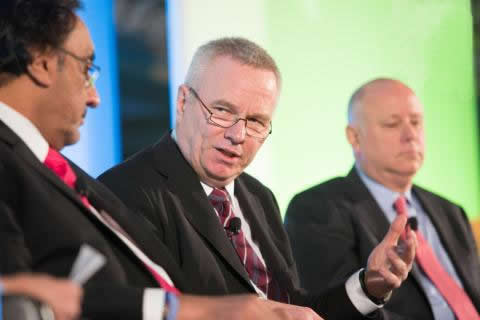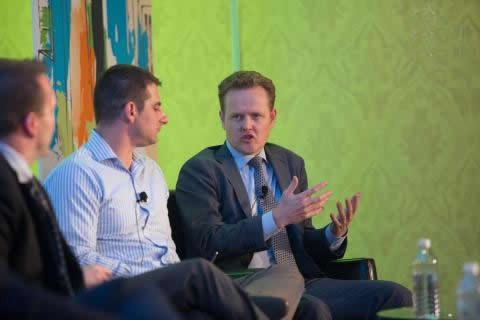Industry leaders at FIA's Futures and Options Expo in Chicago discuss how blockchain technology can be used in the financial markets.
Blockchain has rapidly become one of the hottest topics of discussion in the futures industry. At FIA's Futures and Options Expo in Chicago last November, the industry's largest annual gathering, it was standing room only during panel discussions on blockchain, as executives discussed ways to apply this technology to trading, clearing and other processes in financial markets.

Andreas Preuss of Eurex, speaking at the Expo, said his exchange is looking at potential uses for blockchain technology.
Given blockchain’s potential, several high level industry executives speaking at FIA’s Expo said they are looking at the potential uses for this technology. Andreas Preuss, the head of Eurex, commented that exchange leaders would be “complete fools” if they dismissed the technology’s potential to disrupt existing business functions. Jeffrey Sprecher, chairman and chief executive officer of Intercontinental Exchange, added that the technology is driving a dialogue about “common standards” for digital recordkeeping, and predicted that it will lead to efficiencies in back office functions.
Just a couple of years ago, blockchain was viewed as an exotic and slightly suspicious process tightly linked to the digital currency bitcoin. Now a whole range of market participants see the potential for significant market efficiencies, and billions of dollars have been invested in developing uses for this innovation.
What is Blockchain?
In one sign of this surge of interest, more than three dozen of the world's major global banks have joined together in a consortium to build a framework to use blockchain technology in the financial markets. In addition, major exchanges and market participants such as the London Stock Exchange, CME Group, Euroclear, Societe Generale and UBS have set up a special working group to explore how this technology can be used in clearing, settlement and reporting of trades. Nasdaq has gone a step further, putting blockchain to work for smaller private equity transactions with the hopes of expanding into other types of transactions.
In simple terms, blockchain is essentially a record or ledger of digital events shared among various parties in a transaction. In contrast to a centralized database such as what a clearinghouse might use to track open positions, blockchain technology can be used to maintain records that are distributed across a network. Each record, or block, is added to the blockchain in a linear, chronological order and each computer, or node, connected to the network gets a copy of the blockchain as records are added.
During a discussion on blockchain at FIA Expo, Dan Connell, managing director and head of market structure and technology at Greenwich Associates, explained that blockchain is like an Excel spreadsheet with multiple users able to access it and make changes, all of which are permanently recorded and visible to everyone accessing the document.

Frederik Voss, vice president of blockchain innovation at NASDAQ, discussed how his exchange has begun to use the technology.
One example of a current user in the exchange world is Nasdaq. The exchange is running a pilot program for private securities transactions with five clients, according to Frederik Voss, vice president of blockchain innovation. "Instead of having their shares in paper certificate format, they will only exist as a registration, or as a transaction, on the blockchain," he said.
Voss added that this is just the first area where Nasdaq sees blockchain as a useful tool. "It’s a technology that we think holds great promise for other applications, for financial assets, for example, because of its immediacy, because of the immutability, because of its sort of long opening hours, or operational hours, if you want to call it that," said Voss.
Another example is Symbiont, a financial technology company working on blockchain applications. Ron Papanek, managing director at the company, was one of the speakers at a blockchain panel at FIA Expo and explained that the company used blockchain to digitize and publish records related to its ownership structure. Its founders’ stakes, as well as shares and options granted to employees, have been converted into encrypted code. "We're a startup company, and all the ownership, the convertible bonds, the equity, are all issued on the blockchain," he said.
Putting It to Work
So how might blockchain be applied in the derivatives world? One example could be the reconciliation of records. Papanek said blockchain technology could greatly simplify this process because of the way records are stored in a distributed ledger. "You can eliminate significant – almost 100% – of reconciliation processes because each node is simultaneously validating the transactions.”
Matt Hughes, vice president of strategic planning and development at OCC, the Chicago-based clearinghouse, echoed Papanek's comment. He explained that his company is researching blockchain and exploring opportunities for its use, and believes blockchain could likely make processes such as clearing and settlement more efficient.
Highlights from exchange CEOs at FIA Expo 2015 from MarketVoice on Vimeo.
Hughes said that the biggest value in the technology is that it is immutable. "You are not making a change to the ledger, you are adding new information, so if you need to change a trade, you post a new transaction that negates the first, but the [original] record is still there,” he explained.
Settlement is another key area where blockchain could help ultimately reduce capital requirements, said Brendan Bradley, chief innovation officer at Eurex. If settlement times could be reduced to 10 minutes instead of two or three days, that would allow traders and brokers to use their capital far more efficiently, he explained. “If you can have settlement in 10 minutes, you don’t have to maintain capital for three days – you can release it in 10 minutes,” Bradley said.
Greenwich Associates' Connell cautioned that adoption of blockchain will take time. “Are we going to see major transformations in 2015 and 2016? That’s way too early in our view. Private transactions and private shares are less volume, less complicated and have more pain points in the marketplace.” He added, “You don’t have to change some established behavior or a huge established infrastructure.”
Nasdaq’s Voss agreed. “We think it will be very, very difficult to take two large jumps; this will be a journey of very many small steps, at least initially, for it to work. If you try to take two large steps, there is a risk the whole thing falls over.”
Some industry players are taking a collective approach, forming consortiums to share expertise. One example is R3CEV, a firm that is working with a group of 42 leading banks from Europe, North America and Asia to explore potential uses for blockchain. David Rutter, managing partner of R3CEV, said the project is still at an early stage of development, but predicted that blockchain ultimately will create operational efficiencies in several aspects of trade processing. During a panel discussion at FIA Expo, Rutter explained that today, if two parties enter into a derivatives trade, each side records the details separately, and then they have to use a third party to confirm that they see it the same way. But if the industry can use the blockchain technology to push this process out of the firm and onto the level of the market, and the data can be verified so that everyone is recording it the same way, then it can create tremendous efficiency for market participants if two parties enter into a derivatives trade, each side records the details separately, and then they have to use a third party to confirm that they see it the same way. But if the industry can use the blockchain technology to push this process out of the firm and onto the level of the market, and the data can be verified so that everyone is recording it the same way, then it can create tremendous efficiency for market participants.
"That would dramatically change this cost balance, which is why banks are so excited, and behaving differently," he said. "They want to collaborate and try to achieve network effects. I see them sharing experiments and results to try to accelerate things,” said Rutter.
R3CEV is trying to develop a base communication layer for all blockchain technologies, he added. “Whether we are successful or not remains to be seen, but we are working with some big technology companies to try to do that. The value-added apps would sit on top.”
Disruption or Renovation?
Blockchain is often viewed as a "disruptive" technology that will bring about drastic change in the financial industry, much like Napster and Apple did to the music business. But industry experts at FIA Expo commented that blockchain could turn out to be more of a "sustaining" technology that improves existing processes by making them more efficient.
Greenwich Associate's Connell said the two views are not mutually exclusive. The technology and opportunities can be disruptive to a lot of market participants, and many are investing in analysis to see what it could mean for them. “No one is sitting back with their ivory tower and saying this is not going to affect me,” he said.
David Ripley, chief executive officer of Glidera, a software company that provides developer tools for a series of blockchain applications, agreed. Early steps are driving efficiency, he said, and disruption will take longer. “You have to build out the structure and gain adoption,“ he said.
Voss said that addressing inefficiency will disrupt those business models that depend on inefficiency. “The really exciting disruption comes when we can, using technology, create market structures that can't be supported with today’s technology. We can think about that today, but it is difficult to see. It could satisfy needs we didn’t know we had. We didn’t know five years ago that we had a need for the Uber app. Piling innovation on top of innovation leads to that.”


